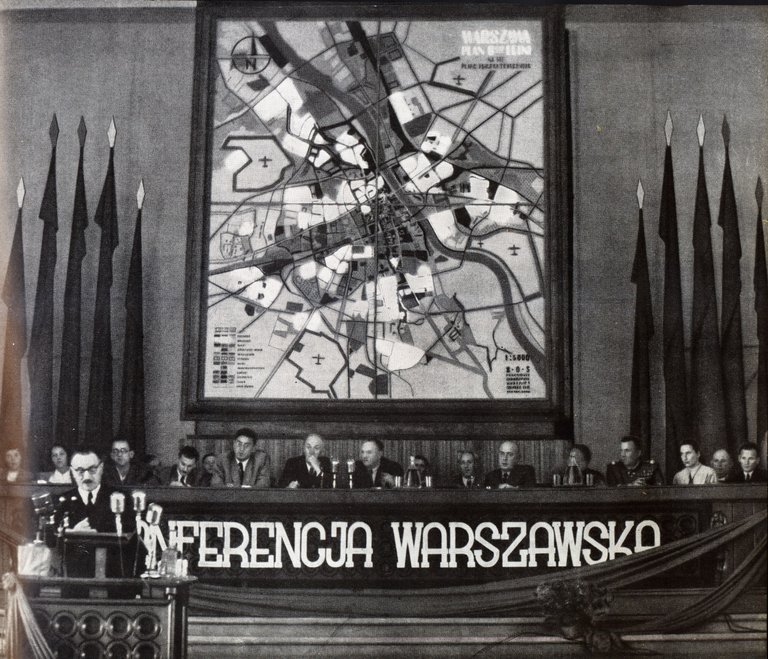
Poland has a long history of being invaded and occupied, owing to their geographic location between Germany and Russia. Between 1795 and 1918, they were invaded, partitioned, and occupied alternately by Prussia, the Czarist Russian Empire, and the Austro-Hungarian Habsburg Empire. After the first World War, the Second Polish Republic was established as an independent state, but that independence was short-lived. Nazi Germany invaded Poland on September 1, 1939, triggering the start of World War II. The Soviet Union invaded the eastern territories of Poland a few weeks later on September 17, 1939. These two powers had earlier (in August) signed the Molotov-Ribbentrop Pact, a non-aggression treaty dividing territories of eastern Europe into German and Soviet control, respectively. Poland was divided between the two at a boundary known as the Curzon Line. Nazi Germany violated the agreement in June of 1941 by attacking Soviet positions in Poland, and later invading Russia itself. The Soviet Union then joined with the Allies to fight Nazi Germany, reclaiming Poland by war's end.
In February of 1945, U.S. President Franklin D. Roosevelt, British Prime Minister Winston Churchill, and Soviet Leader Joseph Stalin met at the Yalta Conference to discuss their objectives for the war and the coming postwar fate of several European countries, including Poland. Churchill wanted assurance that Poland would once again be a free and democratic sovereign nation; indeed, it was in defense of Polish freedom that Great Britain had entered the war in the first place. Stalin, whose troops were already occupying Poland, was more interested in security. Russia had been invaded twice in the previous thirty years by the Germans, and he wanted a "buffer zone" under Soviet control to protect against another invasion from the west. A compromise was reached, whereas a provisional government was created to administer the country until free elections could be held. The Provisional Government of National Unity, as it was called, was controlled by communists in practice. The Polish Government in Exile, formed in 1940, remained in London, virtually powerless.
Later that year at the Potsdam conference, the three Allies hammered out border adjustments, with the Soviet Union annexing Poland's eastern territories, and compensating Poland by moving its western border into previously German lands.
The communists in the Provisional Government (who were mostly Soviets) spent the next two years consolidating their power over the country, despite the lack of popular support from Poles. They enforced ethnic cleansing (via forced deportations) of Germans from the west and Ukrainians from the east, rejected funds from the American Marshall Plan, and arrested and tried sixteen members of the Polish anti-Nazi underground in Moscow. Around 150,000 Poles were apprehended and imprisoned by Soviet forces between 1945 and 1948. The Red Army and the Soviet NKVD (which later became the KGB) worked to suppress the major opposition party, the Polish People's Party (PSL), and any other enemies, real or imagined. All "right wing" (anti-communist) parties were outlawed in 1946.
When the time came for the "free and unfettered" elections promised in the Yalta agreement, Stalin knew that the Poles would reject a pro-Soviet government. After all, Poland had suffered great atrocities during WWII at the hands of the Red Army, including the Katyn Massacre (the execution of about 22,000 Polish officers and intelligentsia), the imprisonment of about 500,000 Poles during the initial invasion of the Kresy region, the deportation of 320,000 Poles to Siberia, and the raping of around 100,000 Polish women during the Soviet counter-offensive. The Polish Home Army had staged the failed Warsaw Uprising in the hope of defeating the Nazis before the arrival of the Red Army, in order to avoid Soviet occupation.
In the months leading up to the 1947 parliamentary elections, opposition candidates and supporters were harassed, persecuted, and finally arrested. When the ballots came in, some ballot boxes were destroyed and in many areas the ballots were simply never counted. The results were determined ahead of time by Stalin himself, with the Pro-Soviet Democratic Bloc winning an overwhelming 80% of the popular vote and 394 of the 444 seats in the Sejm (Polish parliament). In 1948, the Polish communists forced the minority Polish Socialist Party (PSL) to merge with them into the Polish United Workers' Party (PZPR), with Stalinist hardliner and NKVD agent Boleslaw Bierut as the President of Poland (pictured above.)The PZPR would maintain one-party rule until January of 1990.
No further elections were held during this period.
The western allies voiced weak protests, but were unwilling (and in fact unable, especially the war-torn Brits) to go to war with the USSR over Poland. Anti-communist Poles felt betrayed, but the Allies simply could not risk another World War in the immediate wake of the last one. Poland had unwillingly become a Soviet satellite state.
*Citations:
Victor Sebestyen, (2014) "1946: The Making of the Modern World", New York: Penguin Random House
Anne Applebaum, (2012) "Iron Curtain: The Crushing of Eastern Europe: 1944-1956" New York: Penguin Random House
Martin Schain, (2001) "The Marshall Plan" Palgrave Macmillan
Kuzniar-Plota, Malgorzata (2004) "Decision to commence investigation into Katyn Massacre"
Gross, 1997, "Sovietization of Poland's Eastern Territories", "From War to Peace"
AFP/ Expatica, (2009) "Polish experts lower Poland's death toll", Expatica Communications
Joanne Ostrow and Marcin Zaremba, "The Women's Ordeal", Polityka
Warsaw Voice, (2006) " A Capitol Devastated by War"
Dieter Nohlen and Phillip Stover, (2010) "Elections in Europe: A Data Handbook"
Nice to see you are still going well. 😊
Thanks! I try to crank out one post per week, but sometimes I fall short. Great to hear from you.
I upvoted your post.
Mabuhay, keep steeming.
@Filipino
Posted using https://Steeming.com condenser site.